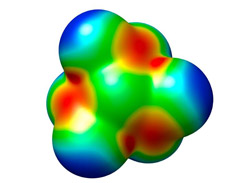Discovery of new molecule can lead to more efficient rocket fuel

Trinitramid – that’s the name of the new molecule that may be a component in future rocket fuel
“A rule of thumb is that for every ten-percent increase in efficiency for rocket fuel, the payload of the rocket can double. What’s more, the molecule consists only of nitrogen and oxygen, which would make the rocket fuel environmentally friendly. This is more than can be said of today’s solid rocket fuels, which entail the emission of the equivalent of 550 tons of concentrated hydrochloric acid for each launch of the space shuttle,” says Tore Brinck, professor of physical chemistry at KTH.
Working with a research team at KTH, he discovered a new molecule in the nitrogen oxide group, which is not something that happens every day. It was while the scientists were studying the breakdown of another compound, using quantum chemistry computations, that they understood that the new molecule could be stable.
“As mentioned, what is specific to this molecule is that it contains only nitrogen and oxygen. Only eight such compounds were previously known, and most of them were discovered back in the 18th century. This is also clearly the largest of the nitrogen oxides. Its molecular formula is N(NO2)3, and the molecule is similar to a propeller in shape,” says Tore Brinck.
The research team, consisting of Martin Rahm and Sergey Dvinshikh as well as Professor Istvan Furó , besides Tore Brinck, has now shown how the molecule can be produced and analyzed. The scientists have also managed to produce enough of the compound in a test tube for it to be detectable.
“It remains to be seen how stable the molecule is in a solid form,” says Tore Brinck.
It was during work to find an alternative to today’s solid rocket fuel that the researchers found the new molecule. The findings are now being published in the respected journal Angewandte Chemie International Edition http://dx.doi.org/10.1002/anie.201007047.
For more information, please contact Tore Brinck at phone:
+46 (0)8 – 790 82 10 or tore@physchem.kth.se
Pressofficer Peter Larsson; press@kth.se; +46-76 050 6960
Media Contact
All latest news from the category: Life Sciences and Chemistry
Articles and reports from the Life Sciences and chemistry area deal with applied and basic research into modern biology, chemistry and human medicine.
Valuable information can be found on a range of life sciences fields including bacteriology, biochemistry, bionics, bioinformatics, biophysics, biotechnology, genetics, geobotany, human biology, marine biology, microbiology, molecular biology, cellular biology, zoology, bioinorganic chemistry, microchemistry and environmental chemistry.
Newest articles

A universal framework for spatial biology
SpatialData is a freely accessible tool to unify and integrate data from different omics technologies accounting for spatial information, which can provide holistic insights into health and disease. Biological processes…

How complex biological processes arise
A $20 million grant from the U.S. National Science Foundation (NSF) will support the establishment and operation of the National Synthesis Center for Emergence in the Molecular and Cellular Sciences (NCEMS) at…

Airborne single-photon lidar system achieves high-resolution 3D imaging
Compact, low-power system opens doors for photon-efficient drone and satellite-based environmental monitoring and mapping. Researchers have developed a compact and lightweight single-photon airborne lidar system that can acquire high-resolution 3D…





















